Water self-priming centrifugal pumps. Submersible or surface - which will be better? Types of centrifugal pumps
Self-priming pump with CRT motor
power 0.29 kW
not available
Water centrifugal pumps with CHN motor
power 0.29 kW
not available
Electric centrifugal pumps with CV motor
article CV
power 0.29 kW
not available
Types and purpose
- Single stage horizontal cantilever
- Monoblock console
- Horizontal with two-way fluid inlet
- Single Stage Vertical Centrifugal Pumps
- Multistage horizontal
- Pumps for reactive liquids
- Fecal centrifugal pumps
- Sand and dredgers
- Centrifugal borehole pumps (semi-submersible, semi-submersible)
Industrial centrifugal pumps are various kinds, targeted directions. Vertical, multi-stage, they perform various functions and have a large number of applications. For example, household electrical centrifugal pump GRUNDFOS CRT series designed not only for the supply of technical water, but also for the purification of sea water. Highly reliable, durable and, most importantly, take up little space. There are also electric monoblock centrifugal CH series motor pumps, which are ideal for irrigation systems used in vegetable farms. There are also more complex units, for example, CHIU series, created to serve even drinking water heating and cooling it on an industrial scale. These centrifugal pumps are hermetically sealed and have a low noise level. Series CHN- horizontal self-priming centrifugal pumps with an electric motor.
Scheme of a centrifugal pump

Principle of operation
In principle, centrifugal force is used. The liquid in the pump, which should be present at the first start, is untwisted with the help of blades on a rotating impeller, but thanks to centrifugal force it moves to the edges of the blades, where it enters the discharge pipe, passing through the spiral chamber. In addition, due to this effect, an area with reduced pressure is created at the entrance to the wheel, so water is automatically sucked out of the tank through the suction tube. As a result, the liquid is constantly moving: from the tank it enters the suction tube, then directly into the pump housing, passes through the valve, and from there it flows through the check valve into the heating tube. To control the process, a vacuum gauge is installed along with a pressure gauge.
Selection parameters and calculation of a centrifugal pump
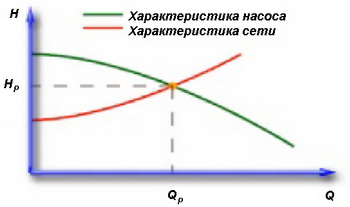
- Pump performance- useful volume flow m 3 / s
- pressure- useful mechanical work reported by the pumped liquid to the force of gravity of this liquid. The head value does not depend on the density of the pumped liquid, which means that the centrifugal pump pumps liquids with the same head.
- Size selection: The performance data Q and head H of the desired duty point required for sizing a centrifugal pump are known. That. you can define the frame size and speed using a characteristic family. The operating point is chosen in close proximity to the performance at the point with the best efficiency.
- Power consumption of centrifugal pump- mechanical energy transmitted from the drive to the coupling or shaft.
It is determined using the following formula.
To ensure the operability of the water supply system, it is not enough to organize a well or a well. It is also necessary to take care of the delivery of water to the house. If the well is located at a distance from the building, and its depth exceeds 10 m, it is advisable to use a horizontal centrifugal pump. Units of this category are capable of supplying water under pressure to a height of more than 80 m, while consuming a minimum amount of energy.
Principle of operation
Performance
The selection of a centrifugal pump in accordance with this parameter entirely depends on the water flow in the water supply system. The performance of the unit should somewhat exceed the needs of residents in the water. The summation of the flow rate of the liquid by all "consumers", in other words - washbasins, showers, sinks, allows you to determine the required value. washing machines, other plumbing fixtures.
Advantages
Advantages centrifugal pumps can be conditionally divided into functional and constructive.
Such units are extremely compact due to the connection with the electric motor and As a result, the units themselves have small dimensions, low weight, despite the impressive performance. The installation of a centrifugal pump requires a minimum of free space and a relatively light foundation.
Among the functional advantages, it is worth noting the simple adjustment and quick activation. Centrifugal pumps deliver fluids continuously and extremely smoothly. In this case, the likelihood of hydraulic shocks in the pressure line is significantly reduced.
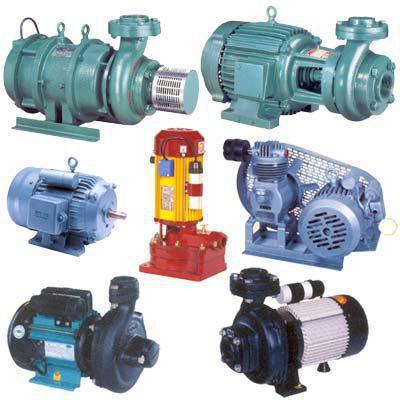
Such equipment is suitable for pumping substances with a high content of impurities, suspensions and solids.
The budget cost of most models is a consequence of the use of inexpensive bases, such as steel, polymer compounds and cast iron, as materials for the manufacture.
Applications
Centrifugal pumps are suitable for pumping water of any hardness, temperature, viscosity. As a result, their operation is not limited to the domestic sphere. Often such units are used by oil industry enterprises, utilities, mining companies.
Submersible pumps are used for pumping clean water from wells and wells, draining flooded premises. Giving preference to such equipment for the implementation of these needs, consumers are guided by the possibility continuous work units for a long time.
Centrifugal pumps are widely used as an element of petrochemical plants, food production equipment, and chemical processing facilities.
Operation features
To extend the life of the pump and ensure its trouble-free operation, the unit must be equipped with a certain set of additional elements.
To protect the impellers from the penetration of foreign bodies into the system, the inlet lines of the units are closed with filters and valves. In order to prevent the outflow of the pumped liquid in the opposite direction, pressure gauges are installed to control the pressure level and special
When selecting the dimensions of the pump, they are based on the value of the necessary key characteristics: pressure, performance, which the unit should provide, taking into account the resistance of the water supply system.
Horizontal installation of a submersible centrifugal pump in a well
The centrifugal submersible unit is placed in the well with a cable. As a fastener, a special metal frame is prepared, which is fixed above the tank.
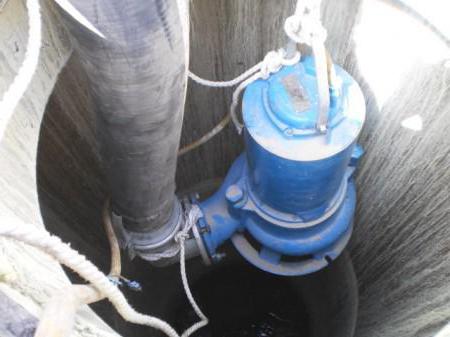
It is carried out in strict sequence:
- The unit is placed at the end of the pipe section, through which it will be connected to the tee that goes into the pipeline.
- A cable is being prepared to connect the equipment to the network.
- TO check valve pump, a brass or plastic coupling is attached, which, in turn, is joined to the pipe.
- After combining the safety cable, pipe and electric cable into a single structure, the pump slowly lowers into the well.
- When the submersible unit is at the required depth, the cable is fixed on a previously prepared metal frame.
- The vertical pipeline is connected to a tee inside the well.
- An electric cable is brought out, and, if necessary, it is launched into a trench leading to the house.
Upon completion of the above activities, you can focus on laying the pipeline in the foundation of the structure and its connection to the location of the equipment, whether it be a boiler, a hydraulic accumulator, or a water filter.
Eventually
Centrifugal pumps are among the largest group of equipment designed for pumping liquid substances. As you can see, the units of this category are somewhat different in scope and functionality. Household appliances serve clean water and liquid with minor impurities, industrial models can be used to work with fairly aggressive media.
Among the variety of pumps used for pumping liquids, the most common are centrifugal units. This technique combines high performance and powerful pressure, but at the same time it has a relatively simple device and compact dimensions.
This article discusses horizontal centrifugal pumps. We will talk about their design and principle of operation, as well as get acquainted with the classification of such equipment and give recommendations for its installation.
1 Design features and principle of operation
Centrifugal pumps, depending on the shape of the casing, are classified into two types - horizontal and vertical. In the vertical version, submersible downhole equipment is mainly produced, all other types of surface pumps have a horizontal device.
The design of centrifugal units consists of such main components as a housing (also referred to as a "snail"), a rotation shaft, an impeller fixed to it, an electric motor and sealing elements. The impeller consists of two flat discs connected by blades. The plates forming the blades have a convex shape, their curved side is located in the direction opposite to the direction of rotation, which provides more efficient water intake.
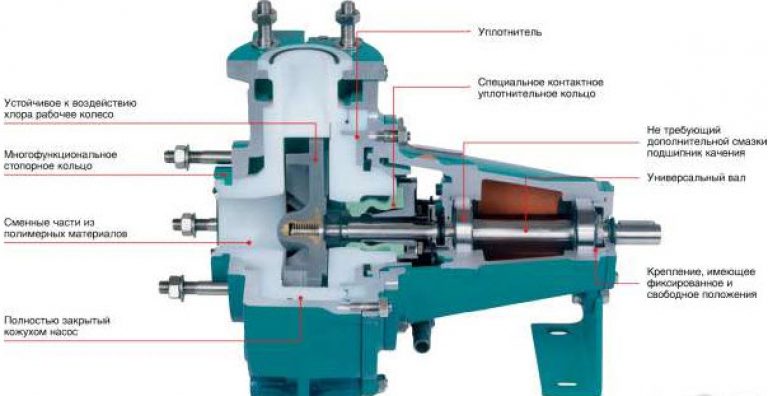
The pump housing is made of metal or stainless steel, while the impeller is most often made of polymer materials. The rotation shaft, which transmits torque to the wheel, is connected to the engine pulley using a coupling. All openings in the housing are sealed, the quality of which directly affects the life of the pump. There are two types of seals - mechanical and gland packing, when choosing a pump, we recommend focusing on units with a mechanical seal, since it is less subject to wear.
In addition to the main structural units, the centrifugal pump is equipped with the following auxiliary mechanisms:
- mechanical filter (installed on the suction pipe);
- non-return valve that prevents the movement of pumped water in the opposite direction;
- valves, allow you to leave the pump filled with water upon completion of work;
- vacuum gauge, to control the mode of operation of the equipment.
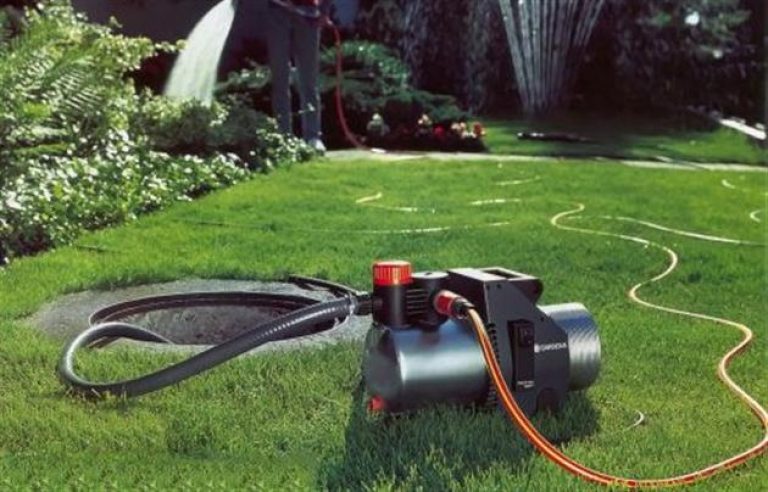
Centrifugal units have a fairly simple principle of operation. In the process of rotation, the impeller under pressure ejects water, which is filled with the housing, to the outlet pipe, as a result of which a zone of low pressure is created near the inlet of the housing, which leads to the suction of water through the intake hose. This principle of operation requires that the pump housing be filled with water before starting.
The advantages of horizontal centrifugal pumps include high productivity and delivery pressure, relatively silent operation, simplicity and maintainability of the design, affordable cost and reliability. The disadvantage of this technique is one - centrifugal pumps are not designed to operate in low productivity mode, they are not able to develop a strong pressure when pumping a small amount of water.
1.1 Overview of the horizontal pump device (video)
2 Classification of horizontal centrifugal pumps
Horizontal pumping equipment is subject to classification according to the following criteria:
- number of impellers;
- type of placement of the electric motor;
- functional purpose.
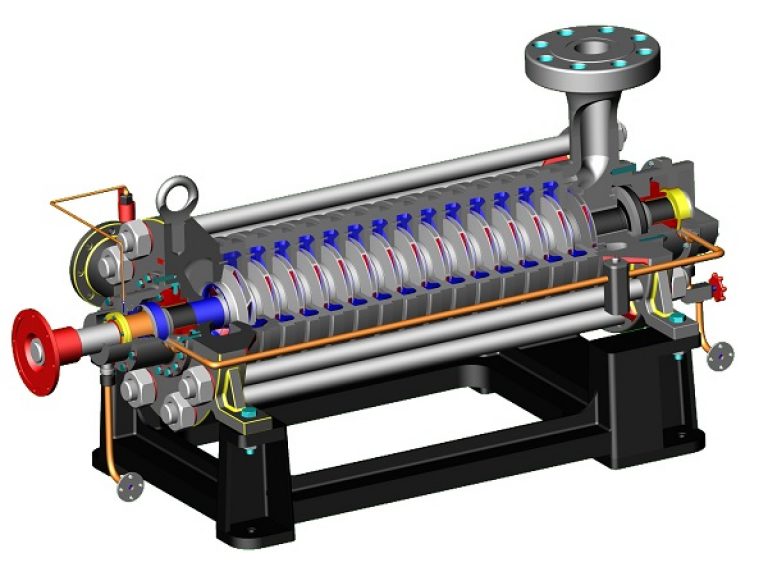
Depending on the number of impellers, the units are classified as single-stage and multi-stage. In the domestic sphere, single-stage pumps are widespread, while multi-stage pumps are used when it is necessary to pump water under increased pressure.
Multi-stage units are equipped with several impellers mounted on a common shaft. Their body is designed in such a way that the pumped liquid sequentially passes from the first wheel to the next one, while accelerating by the sum of the pressures of each of them.
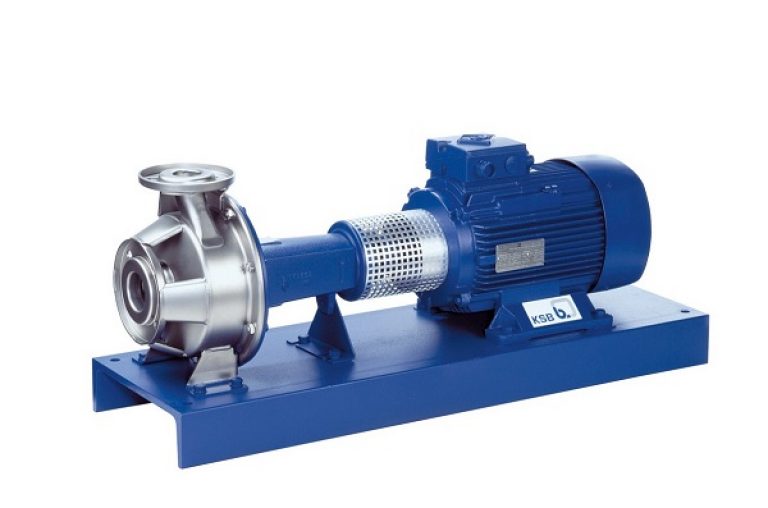
Depending on the type of placement of the engine in the housing, the pump can be:
- cantilevered;
- monoblock.
The monoblock device assumes the location of the motor in the same housing with the impeller, while the wheel is mounted directly on the motor shaft, as a result of which the monoblock pump is smaller and lighter.
Console pump - a unit in which the engine and the impeller are removed from each other (the suction and delivery pipes are located directly in the block with the wheel). Both blocks are mounted on a carrier platform and connected to each other using flanges, the rotation shaft passes inside the protective shell, which is played by a metal pipe.
By functional purpose, horizontal equipment is classified into the following types of pumps:
- water;
- circulation;
- drainage (fecal, sludge).
The water pump, depending on the source of water intake, can be well or borehole. The differences between them are solely in power, the downhole unit is equipped with a more powerful engine, since it needs to raise water from a greater depth.
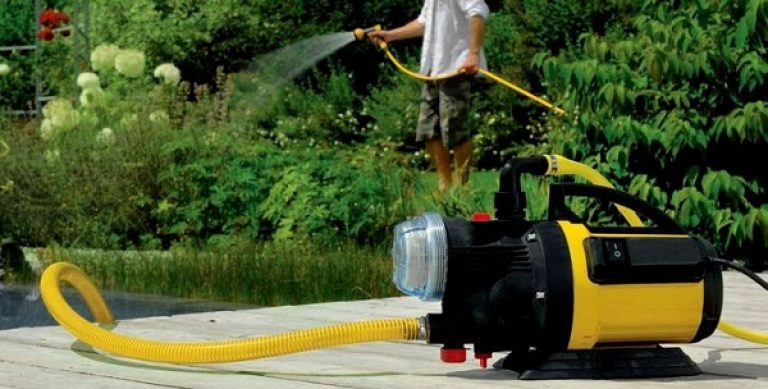
Circulation pump- equipment that increases the speed of movement of the liquid pumped through the pipeline, which is widely used in forced water supply systems and during the installation of radiator heating. A modern circulation pump is equipped with automation that allows you to configure it for the required mode of operation. There are two types of circulators - “dry” and “wet”, they differ in the way the rotor is placed (in the wet version it is immersed in the coolant, in the dry version it is isolated from contact with water). A wet-type circulation pump can have an efficiency factor of up to 50%, a dry one - up to 80%.
Drainage pumping equipment is a technique designed for pumping contaminated liquids. Classical drainage units are used for watering from reservoirs, pumping out contaminated wells and wells. A special fecal pump is designed to drain septic tanks, sewers and cesspools, capable of pumping liquids with an increased concentration of soft fibrous inclusions. In construction, a slurry pump is widely used - a type of drainage equipment focused on working with liquids containing solid abrasive impurities.
2.1 Installation of horizontal pumps and rules for their alignment
Surface horizontal pumps must be mounted in accordance with the provisions of VSN No. 394-78 "Instructions for the installation of compressors and pumps." To install large-sized equipment, it is necessary to equip a foundation plate 10 cm high, on which the frame of the unit is fixed with anchors or blind bolts.
To avoid vibrations during operation, the points of contact between the pump frame and the foundation plate must be equipped with gaskets made of elastic material. With the help of gaskets, the alignment of the pump unit is also carried out, the number of gaskets per one attachment point is no more than 5 pcs. The gap between the base plates of the frame and the foundation plate after the final tightening of the bolts should not exceed 0.05 mm, which is checked using a special feeler gauge.
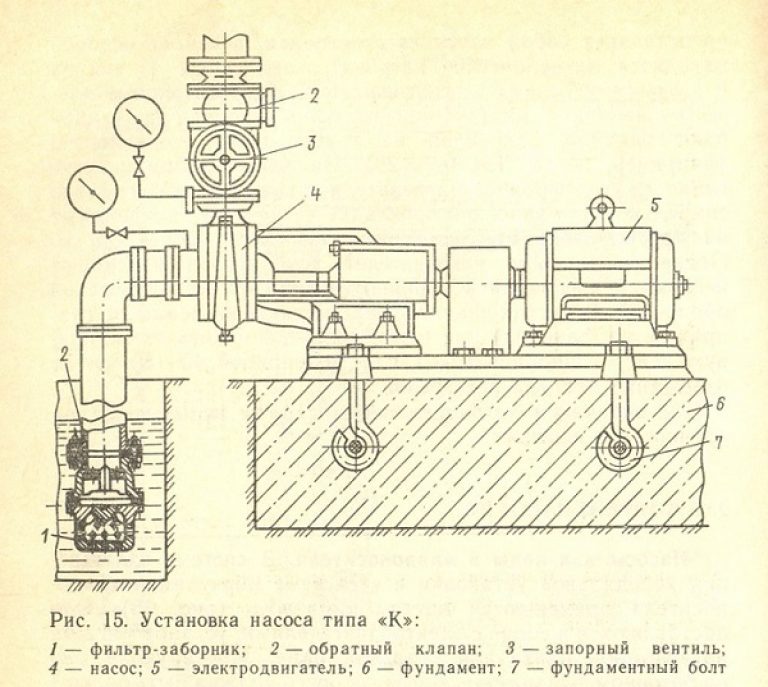
If the unit is mounted in separate units, without a gearbox, the motor must be centered on the pump. The centering itself is carried out by adjusting the position of the housing in relation to the pressure pipeline or fluid coupling.
Of particular importance is the alignment of V-belt pumps. When installing them, special attention must be paid to the evenness of the concrete slab - it is poured along a high-altitude benchmark with strict horizontal control using a level. It is necessary to monitor the parallelism of both the axis of the engine and the shaft of rotation, and the absence of misalignment of the transmission pulleys.
Upon completion of the alignment of the unit, it is necessary to prepare the stuffing box seals for operation, fill in the lubricant and connect the intake and supply pipelines, after which the pump can be started - first in the mode low power, then - with full load.
The problem of water supply of a private house is quite acute. If the building is located in a place where there is no centralized water supply, then the water supply becomes a priority issue. Hot water supply, heating is impossible without a sufficient amount of moisture. Good decision- pumping out liquid from a well or art well. A horizontal well pump will help to cope with this problem.
Such devices must be used only of high quality, because the health of your family depends on the state of the water. Fluid must be supplied from those aquifers where its quality and safety have been confirmed by analyzes.
How the device works
The body and main parts of the pump are made of cast iron or stainless steel, impellers, diffusers, filter made of durable polymer. This allows the equipment to work for a long time in a humid environment without compromising the quality of the pump.
On our website you can purchase high-quality and durable horizontal pumps for domestic purposes, houses or cottages from different manufacturers. The main purpose of horizontal pumps for wells is the supply of water from low content impurities. Such a unit consists of a cantilever-centrifugal pump and an electric motor, they are distinguished by high efficiency.
Single-stage pumps with a double-sided semi-spiral fluid supply to the impeller and a spiral outlet are the most suitable option for individual water supply.
Positive properties of technology
Another feature of horizontal pumps for a well is quality and durability. Such equipment is suitable for organizing water supply with no centralized water supply, all models have a sufficiently high power, anti-corrosion design. Correct installation The device will allow you to constantly replenish water supplies in the required amount.
The catalog of equipment presented on the site will provide an opportunity to get acquainted with the proposed range of products for the water supply of an individual house and choose the best offer.
